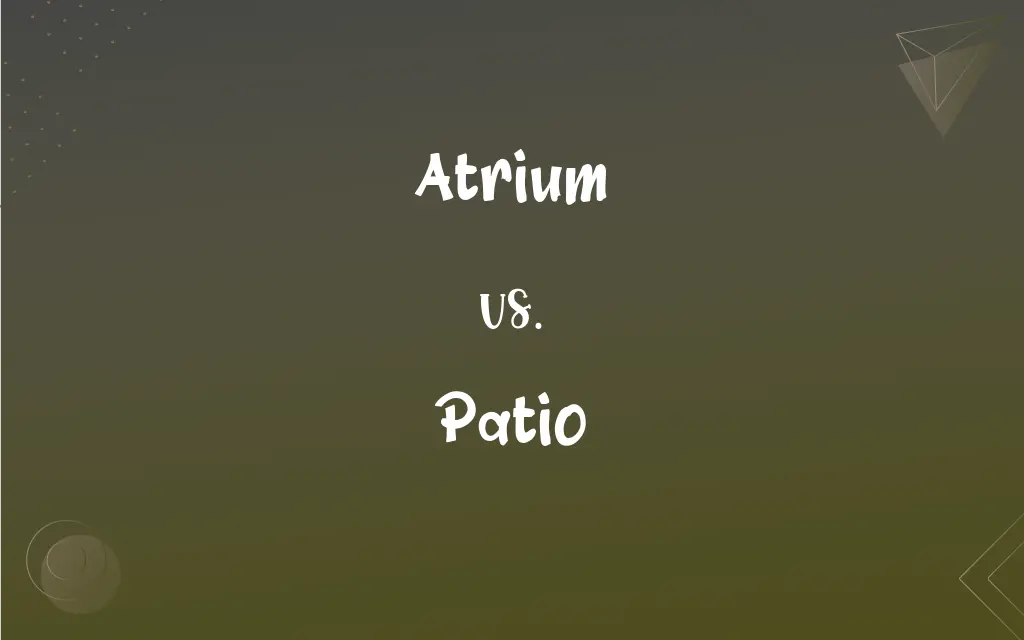Atrium vs. Patio: What's the Difference?
By Janet White & Aimie Carlson || Updated on May 20, 2024
An atrium is an indoor or enclosed space typically within a building, often with a glass roof, while a patio is an outdoor paved area adjacent to a house used for dining or recreation.

Key Differences
An atrium is an architectural feature often found within buildings, typically characterized by a large, open central space. It is usually covered by a glass roof or skylight, allowing natural light to flood the interior. A patio, on the other hand, is an outdoor space that is paved and adjacent to a house. It is designed for leisure activities such as dining, lounging, or entertaining.
While atriums are enclosed spaces that can provide an indoor garden-like environment protected from the weather, patios are open to the elements, offering direct exposure to sunlight and fresh air. Atriums can enhance the aesthetic appeal and functionality of a building's interior, whereas patios extend the living space outdoors, creating a versatile area for various activities.
Atriums often feature plants, water features, and seating areas to create a serene atmosphere within a building. Patios, meanwhile, are often designed with durable materials like concrete, stone, or brick, and can include features such as pergolas, umbrellas, or outdoor kitchens.
The primary difference between an atrium and a patio lies in their location and exposure to the elements: atriums are enclosed and part of the building's interior, while patios are outdoor extensions of the living space.
Comparison Chart
Location
Inside or enclosed within a building
Outside, adjacent to a house
ADVERTISEMENT
Roof
Usually covered with a glass roof
Open to the sky
Usage
Central gathering, aesthetic focal point
Leisure, dining, recreation
Climate Exposure
Protected from weather
Exposed to weather
Common Elements
Plants, water features, seating areas
Outdoor furniture, grills, fire pits
Atrium and Patio Definitions
Atrium
Central open space within a building.
The hotel lobby featured a stunning atrium filled with tropical plants.
ADVERTISEMENT
Patio
Open to weather conditions.
The patio umbrella provided shade on hot summer days.
Atrium
Sometimes designed as an indoor garden.
The atrium served as a peaceful indoor garden for the office workers.
Patio
Paved outdoor area adjacent to a house.
They enjoyed their morning coffee on the sunny patio.
Atrium
Often has a glass roof or skylight.
Natural light streamed through the glass roof of the atrium.
Patio
Often made of stone, brick, or concrete.
The patio was beautifully paved with flagstones.
Atrium
A central space for gathering or aesthetic purposes.
The atrium was the perfect spot for the corporate event.
Patio
Used for dining and recreation.
The family gathered on the patio for a barbecue.
Atrium
A usually skylit central area, often containing plants, in some modern buildings, especially of a public or commercial nature.
Patio
Equipped with outdoor furniture.
Comfortable chairs and a table decorated the patio.
Atrium
The open area in the center of an ancient Roman house.
Patio
An outdoor space for dining or recreation that adjoins a residence and is often paved.
Atrium
The forecourt of a building, such as an early Christian church, enclosed on three or four sides with porticoes.
Patio
A roofless inner courtyard, typically found in Spanish and Spanish-style dwellings.
Atrium
(Anatomy) A body cavity or chamber, especially either of the upper chambers of the heart that receives blood from the veins and forces it into a ventricle. Also called auricle.
Patio
A paved outside area, adjoining a house, used for dining or recreation.
Atrium
(architecture) A central room or space in ancient Roman homes, open to the sky in the middle; a similar space in other buildings.
Patio
An inner courtyard typical of traditional houses in some regions of Spain.
The flat looks out on a patio on one side and a churro café on on the other.
Atrium
(architecture) A square hall lit by daylight from above, into which rooms open at one or more levels.
Patio
A paved yard or floor where ores are cleaned and sorted, or where ore, salt, mercury, etc., are trampled by horses, to effect intermixture and amalgamation.
Atrium
(anatomy) A cavity, entrance, or passage.
An atrium of the infundibula of the lungs
Patio
In Spain, Spanish America, etc., a court or courtyard of a house or other building; esp., an inner court open to the sky.
Atrium
(biology) Any enclosed body cavity or chamber.
Patio
A usually paved area adjacent to a dwelling, used for outdoor lounging, dining, receptions of guests, etc.
Atrium
(anatomy) An upper chamber of the heart that receives blood from the veins and forces it into a ventricle. In higher vertebrates, the right atrium receives blood from the superior vena cava and inferior vena cava, and the left atrium receives blood from the left and right pulmonary veins.
Patio
Usually paved outdoor area adjoining a residence
Atrium
(anatomy) A microscopic air sac within a pulmonary alveolus.
Atrium
(palynology) A cavity inside a porate aperture of a pollen grain formed by the separation of the sexine and nexine layers, widening toward the interior of the grain.
Atrium
A square hall lighted from above, into which rooms open at one or more levels.
Atrium
The main part of either auricle of the heart as distinct from the auricular appendix. Also, the whole articular portion of the heart.
Atrium
A cavity in ascidians into which the intestine and generative ducts open, and which also receives the water from the gills. See Ascidioidea.
Atrium
A cavity, entrance, or passage; as, the atrium, or atrial cavity, in the body wall of the amphioxus; an atrium of the infundibula of the lungs, etc.
Atrium
Any chamber that is connected to other chambers or passageways (especially one of the two upper chambers of the heart)
Atrium
The central area in a building; open to the sky
Atrium
Acts as a focal point in large buildings.
Visitors were immediately drawn to the grand atrium upon entering the museum.
FAQs
What is an atrium in architecture?
An atrium is a central open space within a building, often covered by a glass roof.
What is the main use of a patio?
A patio is used for outdoor dining, recreation, and relaxation.
Is an atrium always indoors?
Yes, an atrium is typically an indoor or enclosed space within a building.
Do atriums have roofs?
Atriums often have glass roofs or skylights to allow natural light in.
Can patios have roofs?
Patios can have pergolas, awnings, or umbrellas but are generally open to the sky.
How does an atrium benefit a building?
An atrium enhances aesthetics, provides natural light, and serves as a central gathering space.
What materials are commonly used for patios?
Patios are commonly made of stone, brick, concrete, or other durable materials.
What are common features of an atrium?
Common features include plants, water features, and seating areas.
What are typical patio furnishings?
Typical patio furnishings include tables, chairs, loungers, and sometimes grills or fire pits.
Are atriums found in residential buildings?
Atriums can be found in both residential and commercial buildings.
Is a patio exposed to weather conditions?
Yes, a patio is exposed to the elements and weather conditions.
Is a patio part of a building’s interior?
No, a patio is an outdoor space adjacent to a house or building.
Do patios require maintenance?
Yes, patios require regular maintenance to keep them clean and in good condition.
What distinguishes an atrium from other indoor spaces?
An atrium is distinct for its open, central location and often its glass roof.
What is the difference between an atrium and a courtyard?
An atrium is usually enclosed and part of the building’s interior, while a courtyard is an open space surrounded by walls or buildings.
Can an atrium include water features?
Yes, water features such as fountains are common in atriums.
Can an atrium have plants?
Yes, atriums often feature plants and greenery to create an indoor garden atmosphere.
Can patios be used year-round?
Patios can be used year-round with appropriate weatherproofing and heating.
What is the primary purpose of a patio?
The primary purpose of a patio is to extend living space outdoors for leisure activities.
How does a patio enhance a home?
A patio enhances a home by providing additional outdoor living space for various activities.
About Author
Written by
Janet WhiteJanet White has been an esteemed writer and blogger for Difference Wiki. Holding a Master's degree in Science and Medical Journalism from the prestigious Boston University, she has consistently demonstrated her expertise and passion for her field. When she's not immersed in her work, Janet relishes her time exercising, delving into a good book, and cherishing moments with friends and family.
Co-written by
Aimie CarlsonAimie Carlson, holding a master's degree in English literature, is a fervent English language enthusiast. She lends her writing talents to Difference Wiki, a prominent website that specializes in comparisons, offering readers insightful analyses that both captivate and inform.































































